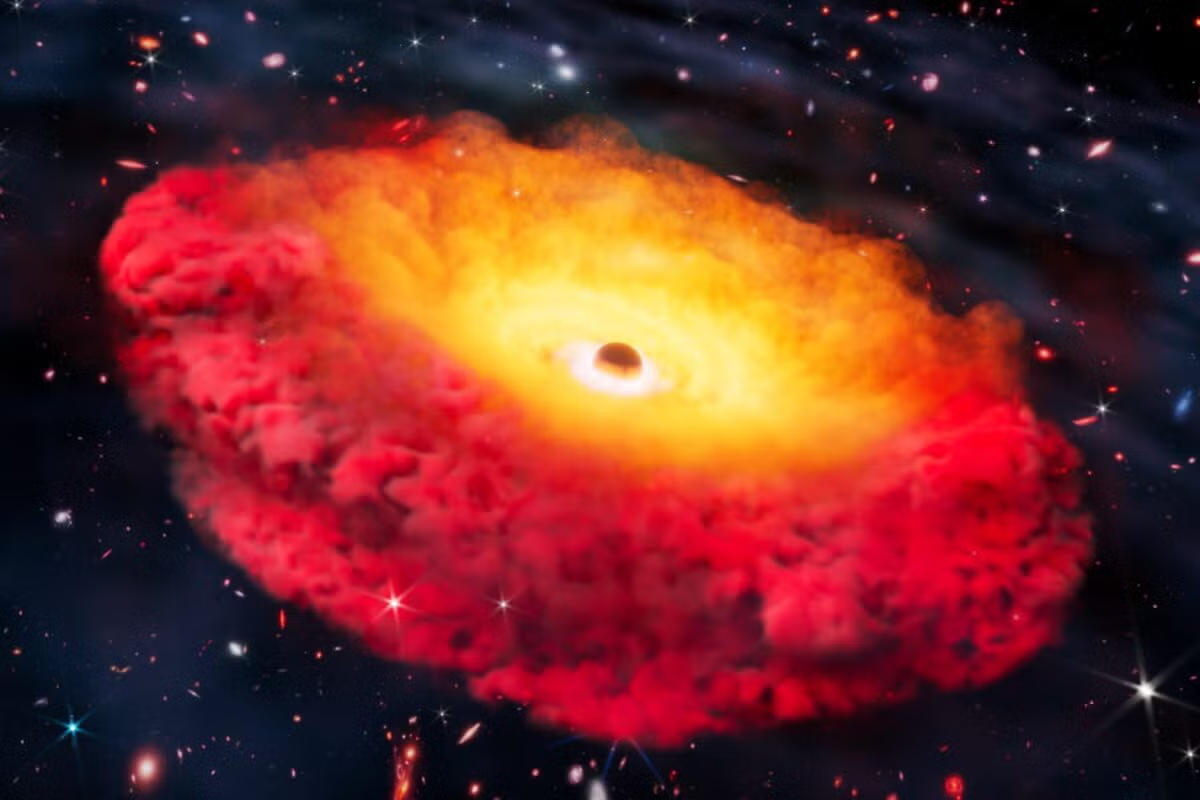An international team of astronomers led by the Cosmic Frontier Center at The University of Texas at Austin has discovered the most distant black hole ever verified. On August 6th, 2025, their study was released in the Astrophysical Journal Letters.

Artist representation of CAPERS-LRD-z9, home to the earliest confirmed black hole. The supermassive black hole at its center is believed to be surrounded by a thick cloud of gas, giving the galaxy a distinctive red color. Image Credit: Erik Zumalt, The University of Texas at Austin
It and the galaxy it calls home, CAPERS-LRD-z9, exist 500 million years after the Big Bang. That was about 13.3 billion years ago, when the universe was just 3% of its current age. As a result, it offers an unparalleled chance to investigate the structure and evolution of this mysterious time.
When looking for black holes, this is about as far back as you can practically go. We’re really pushing the boundaries of what current technology can detect.
Anthony Taylor, Study Lead and Postdoctoral Researcher, Cosmic Frontier Center
“While astronomers have found a few, more distant candidates, they have yet to find the distinct spectroscopic signature associated with a black hole,” said Steven Finkelstein, Study Co-Author and Director, Cosmic Frontier Center.
Astronomers use spectroscopy to separate light into its many wavelengths to examine the properties of an object. They look for signs of rapidly moving gas to detect black holes. Light from gas traveling away from us is stretched into considerably redder wavelengths as it circles and descends into a black hole, whereas light from gas traveling toward us is compressed into much bluer wavelengths.
“There aren’t many other things that create this signature. And this galaxy has it!” explained Taylor.
For their search, the scientists used information from the CAPERS (CANDELS-Area Prism Epoch of Reionization Survey) program at the James Webb Space Telescope. CAPERS offers observations of the outermost edge, while JWST, which was launched in 2021, offers the most expansive views into space.
The first goal of CAPERS is to confirm and study the most distant galaxies. JWST spectroscopy is the key to confirming their distances and understanding their physical properties.
Mark Dickinson, Study Co-Author and Study Team Lead, CAPERS
After first appearing as an intriguing dot in the program’s images, CAPERS-LRD-z9 was found to belong to a brand-new class of galaxies called “Little Red Dots.” These red galaxies are surprisingly brilliant and extremely compact, and were only present during the first 1.5 billion years of the cosmos.
“The discovery of Little Red Dots was a major surprise from early JWST data, as they looked nothing like galaxies seen with the Hubble Space Telescope. Now, we're in the process of figuring out what they’re like and how they came to be,” explained Finkelstein.
That is what CAPERS-LRD-z9 may aid astronomers with.
For starters, this galaxy adds to the growing evidence that supermassive black holes are responsible for the surprising brightness of Little Red Dots. Normally, that level of brightness would point to a galaxy packed with stars. But Little Red Dots appear in an era when such an expansive stellar population seems unlikely.
On the other hand, black holes radiate brightly. This is because they compress and heat the materials they consume, generating enormous amounts of light and energy. Astronomers discovered a stunning example of this relationship in Little Red Dots when they confirmed its existence in CAPERS-LRD-z9.
The newly discovered galaxy may potentially provide insight into the mystery of Little Red Dots' distinctive red tint. That might be due to a dense cloud of gas encircling the black hole, which skews its light into redder wavelengths as it passes through.
“We’ve seen these clouds in other galaxies. When we compared this object to those other sources, it was a dead ringer,” explained Taylor.
This galaxy is also renowned for its massive black hole. Its mass is estimated to be up to 300 million times that of our sun, or almost half that of all the stars in its galaxy. Even among supermassive black holes, this is exceptionally large.
Finding such a massive black hole so early in the universe’s history offers scientists a rare chance to explore how these cosmic giants came to be. A black hole in the later universe has had plenty of time to grow. One that formed within the first few hundred million years, however, would not.
“This adds to growing evidence that early black holes grew much faster than we thought possible, or they started out far more massive than our models predict,” added Finkelstein.
To continue their investigation on CAPERS-LRD-z9, the team wants to collect more, higher-resolution observations with JWST. This might shed further light on it and the function black holes played in the formation of Little Red Dots.
“This is a good test object for us, We haven’t been able to study early black hole evolution until recently, and we are excited to see what we can learn from this unique object,” stated Taylor.
Additional research data were obtained from the Dark Energy Spectroscopic Instrument (DESI) at Kitt Peak National Observatory, an NSF NOIRLab initiative.
Journal Reference:
Taylor, A., J., et al. (2025) CAPERS-LRD-z9: A Gas-enshrouded Little Red Dot Hosting a Broad-line Active Galactic Nucleus at z = 9.288. The Astrophysical Journal Letters. doi.org/10.3847/2041-8213/ade789.